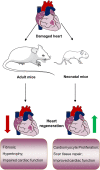Targeting cardiomyocyte proliferation as a key approach of promoting heart repair after injury
- PMID: 35006441
- PMCID: PMC8607366
- DOI: 10.1186/s43556-021-00047-y
Targeting cardiomyocyte proliferation as a key approach of promoting heart repair after injury
Abstract
Cardiovascular diseases such as myocardial infarction (MI) is a major contributor to human mortality and morbidity. The mammalian adult heart almost loses its plasticity to appreciably regenerate new cardiomyocytes after injuries, such as MI and heart failure. The neonatal heart exhibits robust proliferative capacity when exposed to varying forms of myocardial damage. The ability of the neonatal heart to repair the injury and prevent pathological left ventricular remodeling leads to preserved or improved cardiac function. Therefore, promoting cardiomyocyte proliferation after injuries to reinitiate the process of cardiomyocyte regeneration, and suppress heart failure and other serious cardiovascular problems have become the primary goal of many researchers. Here, we review recent studies in this field and summarize the factors that act upon the proliferation of cardiomyocytes and cardiac repair after injury and discuss the new possibilities for potential clinical treatment strategies for cardiovascular diseases.
Keywords: Cardiac repair; Cardiomyocyte proliferation; Cardiovascular disease; Heart regeneration; MicroRNAs; Myocardial infarction.
© 2021. The Author(s).
Conflict of interest statement
The authors declare that they have no conflict of interest.
Figures




Similar articles
-
Regulation of cardiomyocyte fate plasticity: a key strategy for cardiac regeneration.Signal Transduct Target Ther. 2021 Jan 27;6(1):31. doi: 10.1038/s41392-020-00413-2. Signal Transduct Target Ther. 2021. PMID: 33500391 Free PMC article. Review.
-
Mydgf promotes Cardiomyocyte proliferation and Neonatal Heart regeneration.Theranostics. 2020 Jul 11;10(20):9100-9112. doi: 10.7150/thno.44281. eCollection 2020. Theranostics. 2020. PMID: 32802181 Free PMC article.
-
Long Noncoding RNA CPR (Cardiomyocyte Proliferation Regulator) Regulates Cardiomyocyte Proliferation and Cardiac Repair.Circulation. 2019 Jun 4;139(23):2668-2684. doi: 10.1161/CIRCULATIONAHA.118.035832. Epub 2019 Mar 5. Circulation. 2019. PMID: 30832495
-
MicroRNA-34a Plays a Key Role in Cardiac Repair and Regeneration Following Myocardial Infarction.Circ Res. 2015 Aug 14;117(5):450-9. doi: 10.1161/CIRCRESAHA.117.305962. Epub 2015 Jun 16. Circ Res. 2015. PMID: 26082557 Free PMC article.
-
Manipulating Cardiomyocyte Plasticity for Heart Regeneration.Front Cell Dev Biol. 2022 Jul 11;10:929256. doi: 10.3389/fcell.2022.929256. eCollection 2022. Front Cell Dev Biol. 2022. PMID: 35898398 Free PMC article. Review.
Cited by
-
Crosstalk between MST1-Hippo and Wnt/β-Catenin, Notch, and PI3K/Akt pathways in cardiac physiology and pathology.J Physiol Biochem. 2025 Aug;81(3):557-571. doi: 10.1007/s13105-025-01099-2. Epub 2025 Jun 9. J Physiol Biochem. 2025. PMID: 40489018 Review. No abstract available.
-
Signs and signals limiting myocardial damage using PICSO: a scoping review decoding paradigm shifts toward a new encounter.Front Cardiovasc Med. 2023 May 9;10:1030842. doi: 10.3389/fcvm.2023.1030842. eCollection 2023. Front Cardiovasc Med. 2023. PMID: 37229230 Free PMC article.
-
RNA-Binding Proteins as Critical Post-Transcriptional Regulators of Cardiac Regeneration.Int J Mol Sci. 2023 Jul 26;24(15):12004. doi: 10.3390/ijms241512004. Int J Mol Sci. 2023. PMID: 37569379 Free PMC article. Review.
-
IGF2BP3 promotes adult myocardial regeneration by stabilizing MMP3 mRNA through interaction with m6A modification.Cell Death Discov. 2023 May 15;9(1):164. doi: 10.1038/s41420-023-01457-3. Cell Death Discov. 2023. PMID: 37188676 Free PMC article.
References
Publication types
Grants and funding
LinkOut - more resources
Full Text Sources
